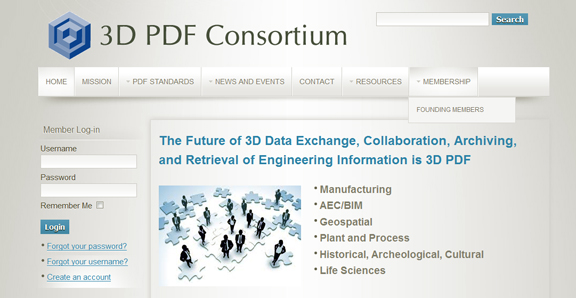Latest News
February 1, 2012
In 2007, when Adobe released Acrobat 3D Version 8, it hailed a new CAD translator and its ability to “convert virtually any CAD file into a highly compressed 3D PDF file.” Squarely targeting the manufacturing crowd, the brochure said, “Use the de facto PDF standard for more secure, reliable electronic information exchange as the foundation of the release process of your CAD data to your customers and suppliers.”
Then, for some reason, Adobe ceased pushing 3D PDF for design collaboration. Fortunately, the company didn’t kill the format. 3D PDF just retreated into a corner, like a neglected puppy.
But the format may have finally found a new home at 3D PDF Consortium, formally incorporated in January 2012. In its announcement, the Consortium described itself as “a group of end users, software vendors, systems integrators, developers and software toolkit providers whose mission is to encourage the continued development and adoption of 3D PDF as a truly open standard for visualization, collaboration, data exchange and the long-term archiving of 3D data across multiple industries and disciplines.”
“Forming the 3D PDF Consortium is a crucial step in keeping this high-value standard strong and responsive to industry needs,” said Phil Spreier, manager of Translation Products for Tech Soft 3D. “The 3D PDF Consortium is the ideal forum to both accelerate the adoption of 3D PDF and ensure its continued focus on real-world workflows driven by the entire community, rather than a single entity.”
With proper industry and user support, 3D PDF could emerge as a rival to other lightweight formats like JT (from Siemens PLM Software) or 3D XML (from Dassault Systemes). There’s also PDF’s dominance as a universal electronic document for displaying graphics, text, and even multimedia. In its announcement, the 3D PDF Consortium pointed out, “Acrobat Reader [is] existing on 98% of connected devices worldwide.”
Founding members include Adobe (the originator of 3D PDF), Anark (specializes in 3D CAD reuse), Aras Corp. (open source PLM), Lattice Technology (specializes in 3D CAD reuse), TechSoft 3D (provides 3D software developer kit), and tetra4D (develops 3D PDF convertor software). Membership in the Consortium is open to all organizations, regardless of size and industry focus. Many members will come together in the group’s first annual meeting in May, scheduled to take place at the same time with 3D Collaboration and Interoperability Conference (3DCIC) in May 21-23 (Denver, Colorado).
Subscribe to our FREE magazine, FREE email newsletters or both!
Latest News
About the Author
Kenneth Wong is Digital Engineering’s resident blogger and senior editor. Email him at [email protected] or share your thoughts on this article at digitaleng.news/facebook.
Follow DE






